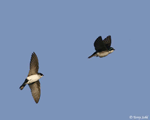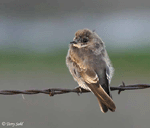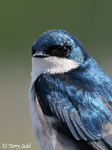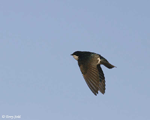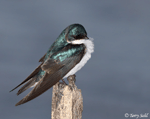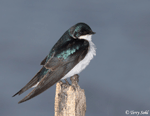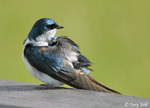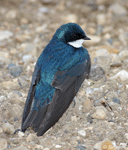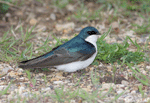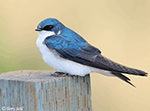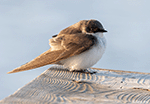Tree Swallow
Tachycineta bicolor
| Length: 6.5 inches | Wingspan: 12.5 inches | Seasonality: Summer |
| ID Keys: Sharply bi-colored, with dark bluish upperparts, and white underparts. Flight feathers blackish. | ||
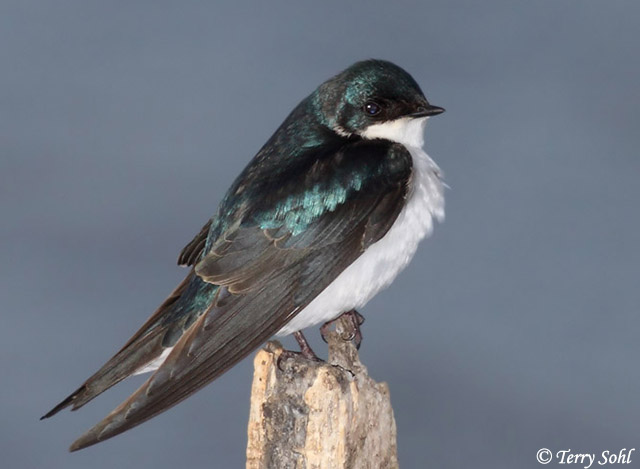 Usually the first of the swallows to arrive in
South Dakota in the spring, the Tree Swallow can survive cold spells by foraging
on berries and seeds. They also winter further north than other North
American Swallows, often congregating in massive flocks on their wintering
grounds. Cavity nesters, Tree Swallows have had to deal with habitat loss
as older trees with cavities are removed, and have also had to deal with
invasive species that compete for tree cavities, such as the
European Starling. However, they have greatly benefited from the
proliferation of bluebird boxes, as they will readily use boxes of that size and
configuration.
Usually the first of the swallows to arrive in
South Dakota in the spring, the Tree Swallow can survive cold spells by foraging
on berries and seeds. They also winter further north than other North
American Swallows, often congregating in massive flocks on their wintering
grounds. Cavity nesters, Tree Swallows have had to deal with habitat loss
as older trees with cavities are removed, and have also had to deal with
invasive species that compete for tree cavities, such as the
European Starling. However, they have greatly benefited from the
proliferation of bluebird boxes, as they will readily use boxes of that size and
configuration.
Habitat:
Tree Swallows will use a variety of open or semi-open country, if foraging and nesting sites are available. Selected nesting locations are typically near water, as their preferred insect prey is often more plentiful there. Flooded timber seems to be a popular nesting location in some spots in South Dakota, as the dead timber often has natural cavities and cavities built by woodpeckers..
Diet:
Most of the diet is made up of insects. Unlike most swallows, tree swallows sometimes eat quite a bit of vegetative material, primarily berries and seeds.
Behavior:
Mostly forages while in flight, feeding on flying insects or swooping to the water's surface to pick up insects. They will also perch in bushes or on the ground to feed on berries, especially when the weather is cold and insects aren't available.
Nesting:
May and June. Tree Swallows are cavity nesters, typically using either natural cavities in trees or those created by woodpeckers. They will also readily nest in human-made nest boxes, using nearly any nest box of sufficient size, from a smaller box built for bluebirds, to a very large box built for Wood Ducks or Screech Owls. Gregarious in all season, Tree Swallows will often nest in loose colonies if sufficient nesting sites are available.
The nest itself is constructed by the female at the bottom of the nesting cavity. It primarily consists of grasses, but may consist of other vegetative material that may be readily available near the nest site. The female uses her body to shape the nesting material into a bowl, often finishing the nest by lining it with feathers. The female lays 4 to 7 eggs, and she alone incubates them. The young hatch after about 14 days, and fledge from the nest about 21 days after hatching.
Song / Calls:
The vocalizations of a Tree Swallow consist of bubbling sounds and soft chirps, given in unpredictable and sometimes long strings. Individual calls consist of similar bubbling or chirping notes.
- Click here to hear a long series of chirping calls from a Tree Swallow1
- Click hear to hear the bubbling calls of a Tree Swallow2
Migration:
Tree Swallows summer in much of Canada and the U.S. Wintering grounds are in the extreme southern U.S. and points south. In South Dakota, they are quite early migrants, particularly for swallow species, with birds starting to arrive as early as the start of April. Their ability to feed on berries gives them the capability to arrive early when insect activity still may be very low.
Interactive eBird map:
Click here to access an interactive eBird map of Tree Swallow sightings
Similar Species:
Tree Swallows have a dapper and clean plumage with a glossy blue upperside, and stark white underside, with a very clean demarcation between the two color palettes. While relatively easy to identify if they are seen well, they could potentially be confused with the following species:
- Violet-Green Swallow - Violet-green Swallows are glossy and colorful on the uppersides, but the tones are deep greenish and purplish, rather than the blue of a Tree Swallow. They share the stark white underside of the Tree Swallow, but the white extends up towards the rump and up above the eye, with the white a little more limited on a Tree Swallow.
- Barn Swallow - Barn Swallows have a glossy, bluish back that could potentially be confused with that of a Tree Swallow. However, they also have a rusty-colored throat patch, a deeply forked tail that's very obvious in flight, and more of a buffy underside than a pure white of a Tree Swallow.
- Purple Martin - Purple Martins have a glossy purplish color on their uppersides that could potentially be confused with the upperside of a Tree Swallow. However, they are purplish all over and lack the white undersides of a Tree Swallow. They are also quite a bit larger.
- Cliff Swallow - Cliff Swallows are often found in mixed flocks with Tree Swallows in South Dakota. They have a bluish back and lighter undersides, but they have several characteristics that differentiate them from Tree Swallows, including a buffy rump patch, a rusty-colored face, and a white to buffy forehead patch.
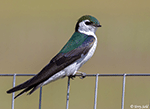 |
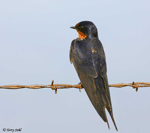 |
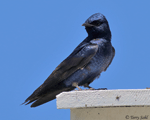 |
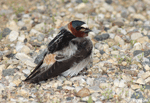 |
| Violet-green Swallow | Barn Swallow | Purple Martin | Cliff Swallow |
Birdhouses:
Tree Swallows will nest in nest boxes of appropriate size, and gourds. Birdhouses built for bluebirds are often utilized by Tree Swallows as well. Click here for information about proper nest box construction and placement for a Tree Swallow.
Conservation Status:
Systematic surveys over the last several decades show quite stable populations of Tree Swallows. They are common and widespread, with no substantial threats to overall populations. The IUCN considers the Tree Swallow to be a species of "Least Concern".
Further Information:
Photo Information:
May 2nd, 2009 -- Lake Thompson, Kingsbury County, South Dakota -- Terry Sohl
Additional Photos:
Click on the image chips or text links below for additional, higher-resolution Tree Swallow photos.
Audio File Credits:
- 1William Whitehead. Recorded in Somerset County, New Jersey on June 19th, 2020. Original recording and information available from xeno-canto.
- 2Bruce Lagerquist. Recorded in Snohomish County, Washington on May 15th, 2015. Original recording and information available from xeno-canto.
| Click on the map below for a higher-resolution view |
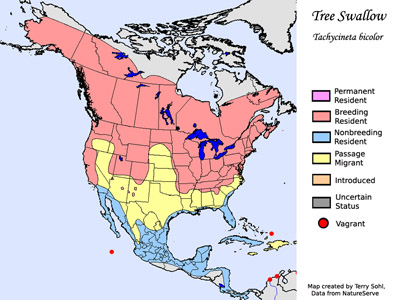 |
| South Dakota Status: Common summer breeding resident in the eastern part of the state, uncommon in the western part. |
Additional Tree Swallow Photos
Click for a higher-resolution version of these photos

